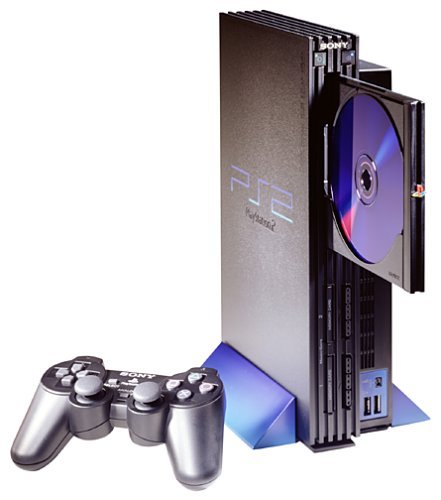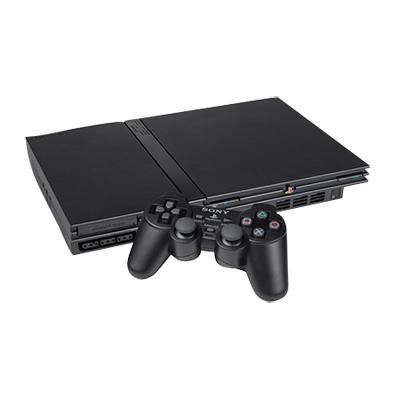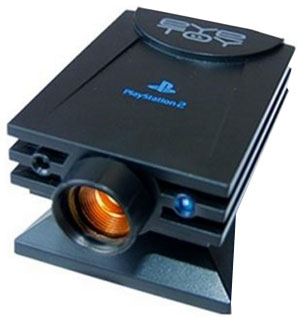Overview

The PlayStation 2 was developed by Sony Interactive Entertainment and was released on March 4th 2000 in Japan, October 26th 2000 in North America, November 24th 2000 in Europe, and November 30th 2000 in Australia. The PlayStation 2 is powered by a 128-bit CPU that Sony co-developed with Toshiba, known as the "Emotion Engine." It was also comprised of a "Graphics Synthesizer" chip (its GPU), a 24x speed CD-ROM (which was also a 4x DVD drive), 2 proprietary controller ports, 2 proprietary memory card slots, a DEV9 expansion bay for a network adapter, and 2 USB 1.1 ports.
The PS2 initially sold well, partly due to the strength of the PlayStation brand and the console's backward compatibility with original PlayStation titles. It sold over 980,000 units by March 5th 2000, or one day after launch in Japan.
Its launch was not without setbacks. Manufacturing delays pushed back the original launch day of the PlayStation 2 to fall in North America. Also, a number of early PlayStation 2 units suffered from disk read errors, which subsequently prompted a class action lawsuit against Sony. Sony agreed to provide free repair services or replacement for the faulty consoles, and continued to do so until February 2005.
At the time, many people in the gaming industry predicted a close match up between the PlayStation 2, Microsoft's Xbox, and Nintendo's GameCube. Several blockbuster games were released for the PlayStation 2 during the 2001 holiday season, which helped maintain sales momentum and hold off its rivals. Sega's Dreamcast was released a full 16 months before the PlayStation 2, but failed to gain momentum. Sega discontinued the Dreamcast in March of 2001, in order to focus on publishing software.
Discontinuation
On December 28th, 2012, Sony confirmed that the PlayStation 2 console had been discontinued in Japan. A week later, Sony confirmed that manufacture of the console had been discontinued worldwide, marking almost 13 years of production for the console. At 150 million units sold worldwide, it is the best-selling console ever.Online
Before the launch of Microsoft's online capable Xbox, Sony placed little emphasis on online gaming during the PlayStation 2's early years. In 2002, however, Sony began heavily advertising several online first-party titles, such as SOCOM: US Navy Seals. Although late, and despite the fact that Sony required developers to pick up the responsibility of providing servers, online gaming was one of the major selling points of the PlayStation 2. The original PlayStation 2 consoles did not have an integrated network adapter, requiring instead that the user purchase the unit separately. The launch of the PlayStation 2 Slim model saw the network adapter built into the console.
PlayStation 2 Slim

In September 2004, in time for the launch of Grand Theft Auto: San Andreas, Sony unveiled one of its major hardware revisions: a smaller, thinner and quieter PlayStation 2 that included a built-in Ethernet port. Called the PS2 Slim, it did not contain a 3.5" expansion bay, thus removing support for an internal hard disk drive. Similar to the GameCube, early models lacked an internal power supply, and had a modified multi-tap expansion. Later models of the PlayStation 2 Slim do not require an external power supply. The removal of the expansion bay was criticized as a limitation due to the existence of titles such as Final Fantasy XI, which required the use of the HDD. The PlayStation 2 Slim model was first released in black, however today the slimline model can be found in silver, white, and pink in North America.
PSX
The Sony PSX (not to be confused with the PlayStation) is a consumer device that can be used as a digital video recorder, DVD burner, and PS2 game player. It also includes built in video, photo, and audio editing software. The device, which has only released in Japan, was poorly received, with some major features absent from the first editions of the hardware. Despite major price drops on the device, sales were very weak in Japan. It is still notable for introduction of the popular XMB interface, now used in Sony's PSP, PlayStation 3, and Bravia TVs.
Accessories and Peripherals
DualShock 2
|
EyeToy
|
PS2 HDD
|
Best Selling Games
- Grand Theft Auto: San Andreas - 17.33 Million
- Gran Turismo 3: A-Spec - 14.89 Million
- Gran Turismo 4 - 10.76 Million
- Grand Theft Auto: Vice City - 9.61 Million
- Grand Theft Auto III - 7.9 Million
- Metal Gear Solid 2: Sons of Liberty - 7 Million
- Final Fantasy X - 6.6 Million
- Kingdom Hearts - 5.9 Million Shipped
- Final Fantasy XII - 5.2 Million Shipped
- Dragon Quest VIII: Journey of the Cursed King - 4.78 Million Shipped
Hardware Specifications
General
- CPU: 128 Bit "Emotion Engine"
- System Clock: 300 MHz
- System Memory: 32 MB Direct Rambus
- Memory Bus Bandwidth: 3.2 GB per second
- Co-Processor: FPU (Floating Point Multiply Accumulator x 1, Floating Point Divider x 1)
- Vector Units: VU0 and VU1 (Floating Point Multiply Accumulator x 9, Floating Point Divider x 1)
- Floating Point Performance: 6.2 GFLOPS
- Compressed Image Decoder: MPEG2
Audio
- Number of voices: ADPCM: 48 channel on SPU2 plus definable by software
- Sampling Frequency: 44.1 KHz or 48 KHz (selectable)
I/O
- CPU Core: Current PlayStation CPU
- Clock Frequency: 33.8 MHz or 37.5 MHz (selectable)
- Sub Bus: 32 Bit
- Interface Types: IEEE1394, Universal Serial Bus (USB)
- Communication: via PC-Card PCMCIA
- Disc Media: DVD-ROM (CD-ROM compatible)
Graphics
- Clock Frequency: 150MHz
- DRAM Bus bandwidth: 48 GB Per Second
- DRAM Bus width: 2560 bits
- Pixel Configuration: RGB:Alpha:Z Buffer (24:8:32)
- Maximum Polygon Rate: 75 Million Polygons Per Second (Theoretical Peak)
- 3D CG Geometric Transformation: 66 million Polygons Per Second (Theoretical Peak)
This page has been seen 199 times.
-
-
Created by on
-

